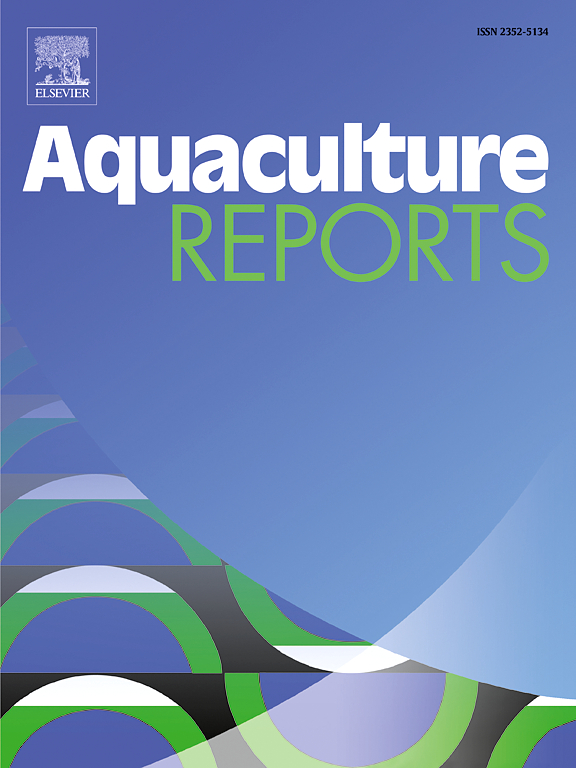精准养鱼:基于传感器的海笼环境下唇颌双颌鱼的研究
IF 3.7
2区 农林科学
Q1 FISHERIES
引用次数: 0
摘要
在不干扰日常管理做法的情况下对养殖鱼类的健康和福利进行远程实时监测对水产养殖业至关重要。本研究评估了无线环境和生物传感器在监测鱼类福利和收集欧洲黑鲈(Dicentrarchus labrax)死亡率和生长的潜在预测因子方面的有效性。环境传感器部署在一个网圈内,8条鱼被植入压力和加速度传感器,以计算单个鱼的加速度和深度。所有传感器都连接到一个中央枢纽,为养鱼户提供实时可视性,并在68天内进行监测。生长与温度、生长与溶解氧水平呈显著正相关。然而,没有发现死亡率数据与所考虑的任何参数(环境、饲料负荷或鱼类相关性状)之间存在显著相关性。我们的研究结果还表明,鱼类的深度和加速度(作为能量消耗的代表)对环境波动很敏感。鱼类在深度和游泳活动中都表现出昼夜节律,白天在较深的水域活动较多,夜间在较浅的水域活动较少。温度、溶解氧和投喂量也影响鱼的游动活动和深度。这项研究表明,利用无线传感器收集的生物和环境数据的声学遥测技术是直接监测海网箱中的鱼类以及环境变化的合适工具。我们还提供了预测欧洲海鲈鱼生长性能的潜力的初步见解。这里提出的分析是初步的,需要进一步完善,包括至少一整年的长期观察和其他参数(如浊度、水流)的结合。此外,研究的可重复性检查是必要的,包括更多的网箱和其他养鱼场。本文章由计算机程序翻译,如有差异,请以英文原文为准。
Precision fish farming: A sensor-based study on Dicentrarchus labrax in a sea cage environment
The remote real-time monitoring of farmed fish health and welfare without disrupting daily management practices is crucial for the aquaculture industry. This study evaluated the effectiveness of wireless environmental and biological sensors in monitoring fish welfare and gathering insights into potential predictors of mortality and growth of European sea bass (Dicentrarchus labrax). Environmental sensors were deployed within a net pen and eight fish were implanted with pressure and accelerometer sensors to compute acceleration and depth of individual fish. All sensors were connected to a central Hub, enabling real-time visibility for fish farmers, and monitoring was carried out over 68 days. Significant positive correlations were observed between growth and temperature, as well as between growth and dissolved oxygen levels. However, no significant correlations were found between mortality data and any of the parameters considered (environmental, feed load or fish-related traits). Our findings also revealed that fish depth and acceleration, which serves as a proxy for energy expenditure, were sensitive to environmental fluctuations. Fish exhibited a circadian rhythm in both depth and swimming activity, with higher activity in deeper waters during the daytime and lower swimming activity in shallower waters during the night. Temperature, dissolved oxygen, and the amount of feed distributed also influenced fish swimming activity and depth. This study demonstrates that acoustic telemetry, by leveraging biological and environmental data collected via wireless sensors, is a suitable tool to monitor fish directly in sea cages, as well as environmental variations. We also provide initial insights into the potential of predicting the growth performance of European sea bass. Analyses presented here are preliminary and require further refinement, including longer-term observations spanning at least an entire year and the incorporation of additional parameters (e.g. turbidity, water currents). Additionally, a replicability check of the study is necessary, incorporating more cages and other fish farms.
求助全文
通过发布文献求助,成功后即可免费获取论文全文。
去求助
来源期刊

Aquaculture Reports
Agricultural and Biological Sciences-Animal Science and Zoology
CiteScore
5.90
自引率
8.10%
发文量
469
审稿时长
77 days
期刊介绍:
Aquaculture Reports will publish original research papers and reviews documenting outstanding science with a regional context and focus, answering the need for high quality information on novel species, systems and regions in emerging areas of aquaculture research and development, such as integrated multi-trophic aquaculture, urban aquaculture, ornamental, unfed aquaculture, offshore aquaculture and others. Papers having industry research as priority and encompassing product development research or current industry practice are encouraged.
 求助内容:
求助内容: 应助结果提醒方式:
应助结果提醒方式:


